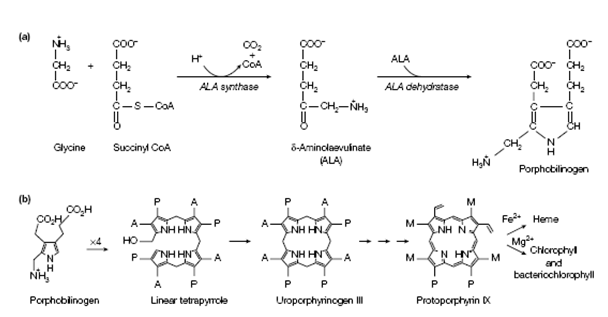Biosynthesis of hemes and chlorophylls:
In animals, some bacteria and fungi, and the first step in tetrapyrrole synthesis is the condensation of the amino acid glycine with succinyl CoA (an intermediate of the citric acid cycle) to built ALA (aminolaevulinic acid). This reaction is catalyzed through the enzyme ALA synthase that needed the coenzyme pyridoxal phosphate and is situated in the mitochondria of eukaryotes. This committed phase in the pathway is subject to regulation. Synthesis of the ALA synthase is feedback-inhibited through heme. In algae, plants and several bacteria there is an alternative route for ALA synthesis which included the conversion of the intact five-carbon skeleton of glutamate in a series of three steps to yield ALA. In all organisms there are two molecules of ALA then condensing to form porphobilinogen in a reaction catalyzed through ALA dehydratase (also known as porphobilinogen synthase). Inhibition of this enzyme through lead is one of the main manifestations of acute lead poisoning.
Four porphobilinogens then condense head-to-tail in a reaction catalyzed through porphobilinogen deaminase to build a linear tetrapyrrole. This enzyme-bound linear tetrapyrrole then cyclizes to form uroporphyrinogen III that has an asymmetric arrangement of side-chains. Uroporphyrinogen III is the general precursor of all chlorophylls and hemes, as well as of vitamin B12. The pathway continues with a number of changes to groups attached to the outside of the ring structure, at last forming protoporphyrin IX. At this point either iron or magnesium is inserted into the middle cavity, committing the porphyrin to either heme or chlorophyll synthesis, respectively. From here further modifications occur, and at last the specialized porphyrin prosthetic groups are attached to their respective apoproteins (the form of the protein consisting of just the polypeptide chain) to build the biologically functional holoprotein.

Figure: Pathway of the synthesis of heme and chlorophyll. (a) Synthesis of porphobilinogen from glycine and succinyl CoA; (b) synthesis of protoporphyrin IX from porphobilinogen. A CH2COOH, M CH3, P CH2CH2COOH.
Heme biosynthesis takes place mainly in immature erythrocytes (85 percent of the body's heme groups), with the remainder occurring in the liver. Various genetic defects in heme biosynthesis have been recognized which give rise to the disorders called porphyrias.